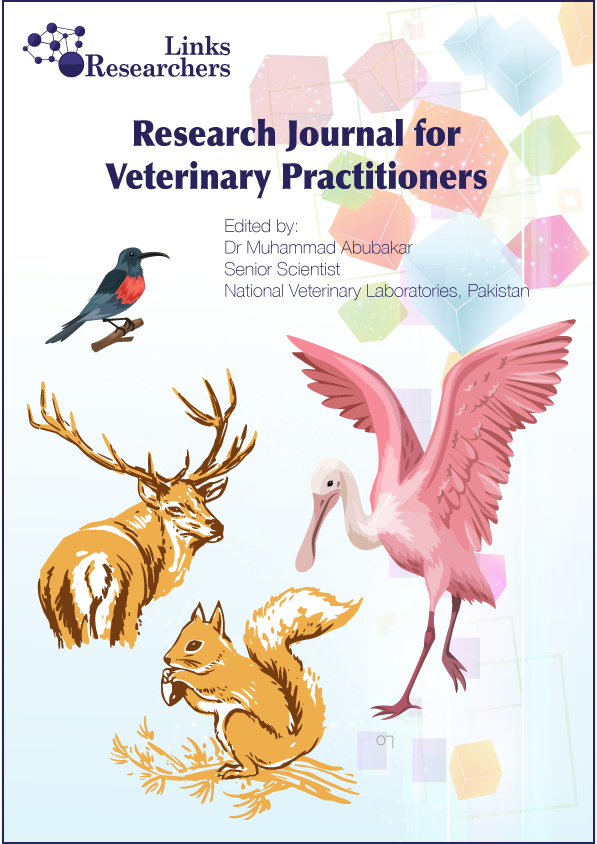Brittany D. Rife 1,2, Marco Salemi 1,2*
E-mail | [email protected]
Muhammad Abubakar1*, Shumaila Manzoor2, Jonas Johansson Wensman3, Emeli Torsson3, Qurban Ali1 and Muhammad Munir4
Shagufta Jabeen1, Muhammad Saqlain Raja1, Sadia Saeed1, Muhammad Mobeen Zafar1, Rizwana Abdul Ghani1, Abid Mahmood1, Muhammad Fiaz2, Pakeeza Arzoo Shiaq1, Shahid Mahmood Baig3, S.M. Saqlan Naqvi1 and Ghazala Kaukab Raja1*
John Gachohi, Simon Karanja, Salome Wanyoike, Nduhiu Gitahi, Salome Bukachi, Kenneth Ngure
Osama Elshazly1, AbdelSatar Arafa1, Mohammed A. Rohaim2, Ismaeil M. Reda2 and Hussein A. Hussein2*
Ateeq ur Rehman1, Syed Atif Hasan Naqvi1*, Ummad-ud-Din Umar1, Muhammad Irfan Zafar1, Faqeer Hussain2, Muhammad Asif Zulfiqar3 and Azhar Ali Khan3
Omer Baris Ince*
Abdul Maalik1, Shahzad Ali1,*, Anam Iftikhar1, Muhammad Rizwan1, Haroon Ahmad2 and Iahtasham Khan1
Amany Adel, Wesam Mady*, Zienab Mosad, Fatema Amer, Asmaa Shaaban, Dalia Said, Marwa Ali Abdel Maged, Abdel-Satar Arafa, Mohamed Kamal Morsi, Mohamed Khalifa Hassan
Amany Adel, Wesam Mady*, Zienab Mosaad, Fatma Amer, Asmaa Shaaban, Dalia Said, Marwa Ali, Abdel-Satar Arafa, Mohamed Kamal Morsi and Mohamed Khalifa Hassan
Ali Mahmoud Zanaty, Naglaa Mohammed Hagag, Neveen Rabie, Mahmoud Saied, Karim Selim, Saad A. Mousa, Azhar Gaber Shalaby, Abdel-Sattar Arafa and Mohamed Khalifa Hassan
Shaikh Abdul Lateef, Zhou Lin, Wu Jian, Junjie Qian, Jonathan Hartanto Tan and Zheng Shusen*
Khaled Kaboudi*
Markus I. Francis1*, Paul I. Ankeli2, Clara N. Kwanashie1, Jibril Adamu1, Lushaikyaa Allam1, Mashood A. Raji3, Godwin O. Egwu4, Flavio Sacchini5 and Massimo Scacchia5
Muhammad Ajmal1, Saima Mustafa1, Fizza Ibrahim Bajwa1, Cheng Zhou2, Guangdong Wen2, Soe Lwin Myint2, Syed Irfan Raza3, Ihtasham Bukhari4, Mubashir Hassan5, Muhammad Faisal6 and Furhan Iqbal1*
Saad A. Moussa1, Ahmed F. Afify1*, Suzan Salah2 and Ayman Hamed3
Hala K. Abdelmegeed 1, Eman M. Abohatab 1, Khattab,O. M. 1 , Salem, S.A.H. 1 , Arafa, A. 2, Nashwa M. Helmy 3
Ayman S. El-Habbaa1 and Mervat E. Radwan2
Fahima Khatun1, Abdullah-Al-Maruf2, Md. Mizanur Rahman2, Afroja Yasmin1, Mohammad Ali Zinnah3, Md. Aminul Islam4 and Mohammad Shah Alam5*
Asmaa G. Mubarak1*, Mona M. Mustafa2, Mohamed W. Abdel-Azeem3, Dina N. Ali2
Sameh Abdel-Moez Ahmed Amer1*, Mohamed Abdel-Aziz Kutkat1, Mohamed Mahmoud Abdel-Baki1, Asmaa Mahmoud Maatouq1, Omnia Mohamed Kutkat2, Hagar Magdy Ahmed1, Khaled Mohamed El-Bayoumi1
Grace Chinenye Onyishi, Chinedu Ifeanyi Atama*, Fejiokwu Esther Chioma, Ifeanyi O Aguzie, Godwin I Ngwu and Christopher Didigwu Nwani
Martha Echioda Ogbole*, James Agbo Ameh, Samuel Mailafia, Olatunde Hamza Olabode and Bridget Jessica Adah
Saima Parveen1, Altaf Mahmood2*, Ayesha Azad3, Sajid Umar4, Nosheen Shoukat6, Mirza Muhammad Arsalan Azam5, Qurat-Ul-Ain5 and Nausheen Akhtar Malik1
Ahmed Abdel-Rady1,2, Walaa Mostafa3*
Uzochukwu Ephraim Emeto, Chukwuemeka Calistus Okolo* and Nwakaego Ernestina Nweze
Nour H. Abdel-Hamid1*, Walid Elmonir2, Eman I. M. Beleta1, Rania I. Ismail1, Momtaz Shahein1, Mahmoud E. R. Hamdy1
Liyun Chang1, Aiju Liu2, Jianshuang Zhang3, Yingbin Chen1 and Zhiyong Liu4*
Amira Adel Taha AL-Hosary1, Walaa Mostafa2*
Omnia Mohamed Khattab1*, Hala Kamel Abdelmegeed2, Mohamed Mahmoud Mashaly1, Mervat Hamdy1*, Naglaa Hagag1, Ayman Hamed3, Hanan Aly Fahmy3, Essam Ibrahim4, Momtaz Abdelhady Shahein2, Elsayyad Mohamed Ahmed2
Shahid Amin1*, Jabbar Khan1, Imran Khan2, Dost Muhammad1, Kamran Ullah Khan1, Naqeeb Ullah Khan1, Muhammad Azhar Jameel3
Ahmed Fathy1, Rania A. Hassan2, Essam S. Soliman3*
Anatoly Murashevich Bittirov1*, Sadrutdin Shamshitovich Kabardiev1, Ayub Yusupovich Aliev1, Boris Kazievich Laipanov2, Svetlana Aleksandrovna Shemyakova2, Ismail Anatolyevich Bittirov1
Hidayat Ullah1, Sadia Tabassum1, Sultan Ayaz2, Shumaila Noreen1, Atta Ur Rehman1, Naveed Akhtar3, Muhsin Ali3, Zaib Ullah3* and Sajid Mahmood1,4
Ahmed Abdel-Rady3*, Mohamed Karmi2, Menna_allah Youssef1, Aml M. Abdel-Ra’ouf1, Bahaaa Madkour1
Hemayet Hossain1, Md. Masud Parvej1*, Khadiza Akter Brishty3, Muhammad Ali4, Junayed Ahmed4, Asibul Hasan4, Rubel Miah4, Md. Piplu Mia4, Saad Muhammad Rafe-Ush-Shan4, Md. Nazmul Alam4 and Md. Zahidul Islam Khan2
Salvator Minani1,2*, Eric Nsengiyumva1, Anatole Bigirimana1,2, Arnaud Cubahiro1,2, Dieudonné Ntakirutimana1,2 and Vénuste Bizoza1,2
Nazia Haider, Asia Bibi* and Nahid Kausar
Muhammad Fiaz Qamar1*, Tahir Hussain1, Iram Liaqat2, Madiha Kiran1 and Abdur Rahman Ansari1
Tariq Jamil1, Muhammad Saqib2*, Abid Rashid3, Muhammad Hammad Hussain4, Khushal Khan Kasi5, Muhammad Haleem Tayyab2, Muhammad Azam Kakar5, Heinrich Neubauer1 and Mudassar Iqbal6*
Raof*, Amal M. A.; Haleem*, Iman Y.; Aly*, Nawal M.; * *Garhy, M.M. and Hosny***, Gehan A.
Abou zead, A.A., Ali, A.A.H.*and Abd El Hkeem M.M.












